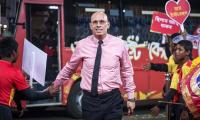The 1857 War of Independence was not just a spontaneous happening but a natural culmination of a number of consistent resistance efforts going back to the battle of Plassey in 1757. These movements included people from different strata of society – rajas, princes, landlords, peasants, religious people, local sepoys in the East India Company, and ordinary people of India in one way or the other were part of the resistance movements.
There were a number of factors that led to the final outburst. These factors were political, economical, and religious in nature. Thus the time was ripe for one final push to dethrone the East India Company. The immediate reason was provided by the East India Company in February, 1857 when a new rifle was introduced.
The greased cartridge for this rifle allegedly used fat from cows and pigs. The soldiers, whose vast majority comprised local Hindus and Muslims, were required to bite pre-greased cartridges to release the powder. Since the cow was sacred to Hindus and the pig forbidden for Muslims, this was unacceptable to both communities. Biting these cartridges would have meant a direct breach of their faith.
Thus the issue of greased cartridge proved to be the immediate reason for the War of Independence that sparked off on March 29, when a young soldier, Mangal Pandey, in the Barrackpore parade ground near Calcutta defied the orders of his commander and opened fire on a British officer. Mangal Pandey was court-martialled on April 6, 1857 and was hanged to death on April 8, 1857. The rebellion at Meerut swelled and the freedom fighters left for Delhi on May 10. Thousands of soldiers reached Delhi on May 11 and requested Bahadur Shah Zafar, the dormant king, to patronise the freedom war.
Bahadur Shah Zafar gave a positive response and held a formal court after many years. The court was attended by many people and thus the freedom fighters got a symbolic leadership in the shape of Bahadur Shah Zafar. The response to this appeal was swift and effective. Bahadur Shah Zafar, himself a weakling, appointed Bakht Khan as chief commander to provide leadership to the freedom fighters. After getting control of Delhi the freedom fighters left for Agra.
Soon the rebellion spread to other parts of the country. There were some major centres including, Kanpur, Lucknow, Bareilly, Jhansi, Gwalior and Arrah in Bihar, where freedom fighters gave a tough time to the forces of the East India Company. In Lucknow, which was the capital city of Awadh, Begaum Hazrat Mahal, the wife of former king of Awadh, led the freedom fighters and gave a tough time to the British forces. The British forces, after an initial setback, captured Lucknow while Hazrat Mahal managed to escape.
Nana Sahib, who was the adopted son of Peshwa Baji Rao II led the freedom fighters, with Tantia Tope, in Kanpur. Kanpur was captured by the fighters and Nana Sahib was declared as Peshwa. The British forces, that were initially defeated, got reinforcements and attacked again. As the British forces pushed the local forces, Nana Sahib managed to escape but Tantia Tope carried on his valiant fight against the British. The British finally captured Kanpur and Tantia Tope was arrested and hanged to death. The captured prisoners were killed by being put in front of fire cannons.
Another centre of action was Jhansi, where freedom fighters were led by Rani Lakshmi Bai who was only 22 years old. She fought bravely. The British, after the initial loss, defeated the forces of Rani of Jhansi who escaped and reappeared in Gwalior with Tantia Tope. Together they attacked Gwalior and captured it. The British fought back and recaptured Gwalior. Rani Lakshmi refused to give up and kept fighting until her death.
In Arrah (Bihar), Kunwar Singh, who was 80 years old, led the freedom fighters who rebelled in Danapur on July 5, 1857. He captured Arrah, district headquarters. The British forces retaliated and Kunwar Singh escaped to Lucknow where he captured Azamgarh in March 1858. He finally moved back to Arrah, his native place and defeated the British forces in Jagdishpur. Kunwar Singh died on April 26, 1858. After his death, his brother, Amar Singh, continued the struggle.
In Bareilly, Khan Bahadur Khan Rohilla led the war against the British forces. He challenged the East India Company and formed his own parallel government in Bareilly. As the British forces pushed the freedom fighters, Khan Bahadur Khan escaped to Nepal, where he was captured and sent back to India. Khan Bahadur Khan was hanged to death on February 24, 1860.
The 1857 war was finally lost by the freedom fighters. One major reason, among others, was the lack of a central leadership. King Bahadur Shah Zafar was a weakling and could not provide an effective leadership. The freedom fighters were handicapped in terms of strategy, coordination, and ammunition. Another reason could be that many parts of India were not directly engaged in this war. Only some major centres were engaged because of the local leadership. Though the war could not achieve its objective of regaining freedom, it succeeded in demonstrating that the people of India could stand up for freedom.
Two major outcomes were achieved as a result of this war. First, the rule of the East India Company came to an end and India came under the British parliament. The second important outcome was the abolition of the Law of Lapse; the emperors of states could now adopt sons who could be their heirs.
But the biggest outcome of the war of freedom was the realisation of the potential vulnerability of the East India Company. The war of freedom successfully stimulated a number of new popular resistance movements in post-1857 era which finally led to the freedom of India in 1947.
The writer is an educationist.
Email: shahidksiddiqui@gmail.com
Regardless of political systems democracy, autocracy, or monarchy no country has progressed without educating its...
This, in turn, has made Riyadh accepted and respected mediator by all conflicting sides
Question of how drugs manufactured by these companies are prescribed is something that amounts to a major scandal
Most prominent speakers at Peshawar convention were Admiral R Ramdas, former Indian naval chief and I A Rehman
BJP leader says that “their politics hinges on security of forces”
Travel services, including flights and hotels, can be booked with Bitcoin through Expedia







